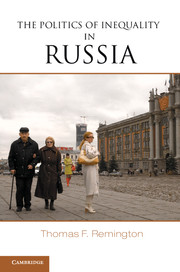Book contents
- Frontmatter
- Contents
- List of Figures
- List of Tables
- Preface
- 1 The Political Sources of Income Inequality in Russia
- 2 Employment, Earnings, and Welfare in the Russian Transition
- 3 Regime Diversity in the Russian Regions
- 4 Democracy and Inequality in the Russian Regions
- 5 Regional Regimes and the Labor Market: Evidence from the NOBUS Survey
- 6 Helping Hands or Grabbing Hands? Government-Business Relations in the Regions
- 7 Accounting for Regime Differences
- 8 After the Crash
- Index
- References
3 - Regime Diversity in the Russian Regions
Published online by Cambridge University Press: 05 June 2012
- Frontmatter
- Contents
- List of Figures
- List of Tables
- Preface
- 1 The Political Sources of Income Inequality in Russia
- 2 Employment, Earnings, and Welfare in the Russian Transition
- 3 Regime Diversity in the Russian Regions
- 4 Democracy and Inequality in the Russian Regions
- 5 Regional Regimes and the Labor Market: Evidence from the NOBUS Survey
- 6 Helping Hands or Grabbing Hands? Government-Business Relations in the Regions
- 7 Accounting for Regime Differences
- 8 After the Crash
- Index
- References
Summary
The formal organization of state power in the Russian regions – officially called the “subjects of the federation” – bears a strong family resemblance throughout the country. This fact, combined with the tendency toward the centralization of power in the country under Vladimir Putin in the 2000s, might suggest that regional differences in formal and informal regime characteristics are insignificant.
Certainly it is the case that chief executives, often called governors even in the ethnic republics headed by presidents, dominate decision making everywhere, echoing the strongly presidential tilt at the federal level. Legislative assemblies, courts, mass media, and civic groups tend to be weak constraints at most on the governors. The actual distribution of power among political and social actors, however, can vary substantially. Even neighboring regions can feature significantly different political regimes. In some regions, governors are handmaidens of a dominant firm, such as an energy or minerals-extracting company. In others, power is more broadly dispersed. In many, the governor rules as a kind of chief executive officer of a state corporation that owns and controls much of the local economy. These patterns vary both over space and over time as particular governors establish their own regimes and as the power of major economic interests waxes and wanes. Systematic measurement of such elusive arrangements has stymied researchers seeking to understand the sources and consequences of this variation.
- Type
- Chapter
- Information
- The Politics of Inequality in Russia , pp. 77 - 109Publisher: Cambridge University PressPrint publication year: 2011



